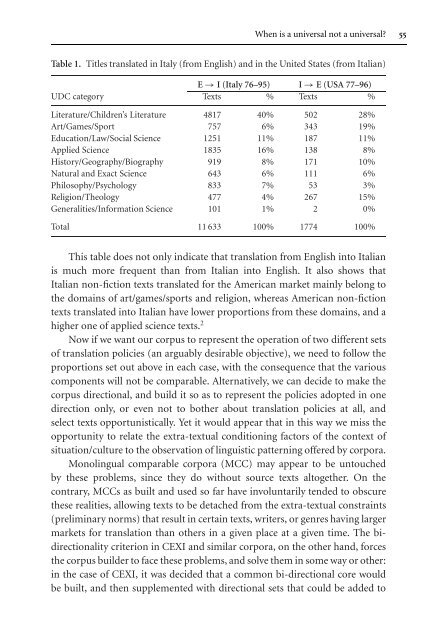Translation Universals.pdf - ymerleksi - home
Translation Universals.pdf - ymerleksi - home
Translation Universals.pdf - ymerleksi - home
Create successful ePaper yourself
Turn your PDF publications into a flip-book with our unique Google optimized e-Paper software.
When is a universal not a universal? 55<br />
Table 1. Titles translated in Italy (from English) and in the United States (from Italian)<br />
E → I (Italy 76–95) I → E (USA 77–96)<br />
UDC category Texts % Texts %<br />
Literature/Children’s Literature 4817 40% 502 28%<br />
Art/Games/Sport 757 6% 343 19%<br />
Education/Law/Social Science 1251 11% 187 11%<br />
Applied Science 1835 16% 138 8%<br />
History/Geography/Biography 919 8% 171 10%<br />
Natural and Exact Science 643 6% 111 6%<br />
Philosophy/Psychology 833 7% 53 3%<br />
Religion/Theology 477 4% 267 15%<br />
Generalities/Information Science 101 1% 2 0%<br />
Total 11 633 100% 1774 100%<br />
This table does not only indicate that translation from English into Italian<br />
is much more frequent than from Italian into English. It also shows that<br />
Italian non-fiction texts translated for the American market mainly belong to<br />
the domains of art/games/sports and religion, whereas American non-fiction<br />
texts translated into Italian have lower proportions from these domains, and a<br />
higher one of applied science texts. 2<br />
Now if we want our corpus to represent the operation of two different sets<br />
of translation policies (an arguably desirable objective), we need to follow the<br />
proportions set out above in each case, with the consequence that the various<br />
components will not be comparable. Alternatively, we can decide to make the<br />
corpus directional, and build it so as to represent the policies adopted in one<br />
direction only, or even not to bother about translation policies at all, and<br />
select texts opportunistically. Yet it would appear that in this way we miss the<br />
opportunity to relate the extra-textual conditioning factors of the context of<br />
situation/culture to the observation of linguistic patterning offered by corpora.<br />
Monolingual comparable corpora (MCC) may appear to be untouched<br />
by these problems, since they do without source texts altogether. On the<br />
contrary, MCCs as built and used so far have involuntarily tended to obscure<br />
these realities, allowing texts to be detached from the extra-textual constraints<br />
(preliminary norms) that result in certain texts, writers, or genres having larger<br />
markets for translation than others in a given place at a given time. The bidirectionality<br />
criterion in CEXI and similar corpora, on the other hand, forces<br />
the corpus builder to face these problems, and solve them in some way or other:<br />
in the case of CEXI, it was decided that a common bi-directional core would<br />
be built, and then supplemented with directional sets that could be added to
















